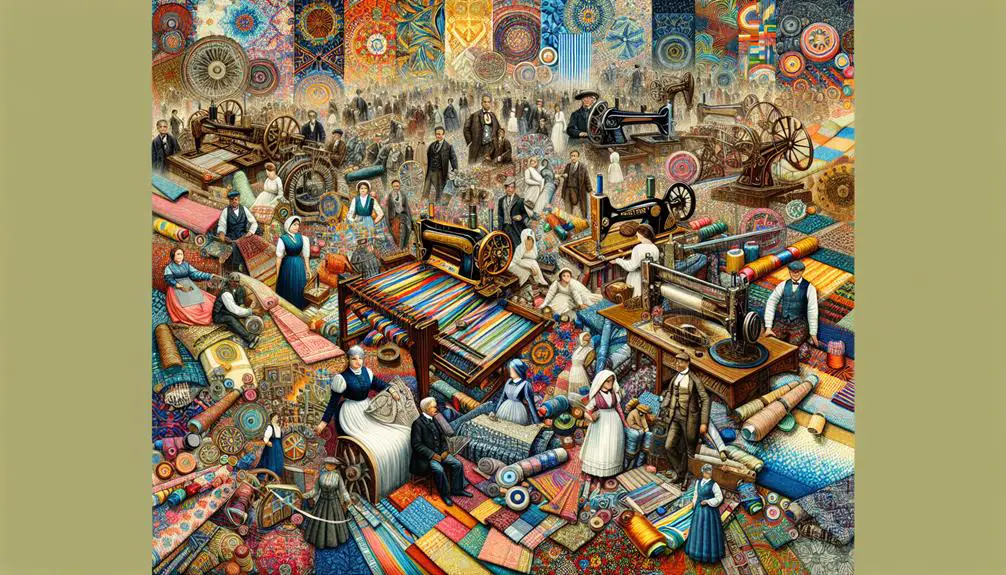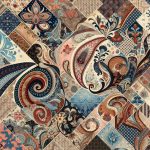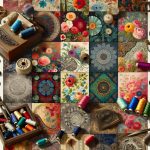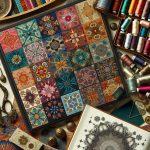Did you know that over 75% of contemporary textile designs are influenced by pioneering fabric designers from the late 19th and 20th centuries? When you think about innovators like William Morris, whose intricate handcrafted patterns set a new standard, or Mariano Fortuny's revolutionary dyeing techniques, it's clear these visionaries have left an indelible mark. As you explore the work of Sonia Delaunay and Jack Lenor Larsen, you'll discover how they blended tradition with modernity, pushing the boundaries of fabric design. Intrigued by how these artists redefined textiles? Let's uncover their unique contributions.
Table of Contents
Key Takeaways
- William Morris championed the arts and crafts movement with intricate handcrafted designs.
- Mariano Fortuny revolutionized textile dyeing and printing methods, blending tradition with modern techniques.
- Sonia Delaunay introduced groundbreaking fabric design methods with vibrant colors and geometric patterns.
- Jack Lenor Larsen innovated textile design with sustainable materials, technology, and unconventional approaches.
- Vera Neumann's nature-inspired and vibrant designs showcase innovative use of color and nature themes.
William Morris
William Morris's revolutionary approach to fabric design has left an indelible mark on the world of textiles. By embracing the principles of the arts and crafts movement, Morris championed a return to handcrafted quality and intricate detail. You can appreciate how his work stands in stark contrast to the mass-produced, overly simplistic patterns of his time. His textile patterns are celebrated for their complexity, featuring lush foliage, intertwined vines, and richly detailed flowers that invite closer inspection.
Morris didn't just design fabrics; he created a philosophy. He believed that beauty should be accessible to all, not just the elite, and that everyday objects should be as aesthetically pleasing as they're functional. This ethos permeated his work, inspiring a generation to view textile patterns as a form of high art.
For those seeking mastery in textile design, Morris's approach offers invaluable lessons. His dedication to craftsmanship, attention to detail, and integration of artistic principles into practical items are principles you can apply to elevate your own work.
Mariano Fortuny
You'll find Mariano Fortuny's contributions to textile dyeing techniques and innovative printing methods truly groundbreaking.
He revolutionized fabric design with his unique approach to color and pattern.
Fortuny's work continues to influence modern designers and remains a benchmark of creativity and technical skill.
Textile Dyeing Techniques
Mariano Fortuny revolutionized textile dyeing with his innovative methods and exquisite color palettes. You'll notice that his approach seamlessly combines traditional and modern techniques, creating a timeless aesthetic.
Fortuny's expertise lies in his capacity to harness both natural and synthetic dyes, allowing for a wide range of colors and finishes. By understanding the distinctions between these dye variations, you can admire the depth and richness that natural dyes bring, while also acknowledging the vibrancy and reliability offered by synthetic alternatives.
Fortuny didn't just stop at selecting the right dyes; he perfected the application process. His meticulous methods ensured that each fabric piece was a masterpiece, reflecting a flawless balance between color and texture.
You can see his influence in the way modern designers approach textile dyeing, often blending ancient methods with contemporary innovations to achieve exceptional results.
For those aiming for mastery in textile dyeing, Fortuny's work serves as an invaluable blueprint. His ability to merge old-world craftsmanship with forward-thinking methods offers a lesson in balancing tradition with modernity.
Innovative Printing Methods
Fortuny's innovative printing methods blend tradition and technology, resulting in fabrics that captivate with their intricate designs and vivid colors. His approach harmoniously marries the old-world charm of manual techniques with modern advancements, making his work timeless and relevant.
When you explore Fortuny's process, you'll discover a mastery that lies in three key areas:
- Eco-friendly processes: Fortuny's commitment to sustainability is evident in his use of natural dyes and environmentally responsible methods. He ensures that his production minimizes waste and reduces the ecological footprint, setting a standard for modern fabric designers.
- Digital printing advancements: Fortuny seamlessly integrates digital printing technologies to enhance the precision and complexity of his designs. This allows for the creation of patterns that are both intricate and consistent, pushing the boundaries of what traditional methods can achieve.
- Combination of techniques: By merging handcraftsmanship with state-of-the-art technology, Fortuny produces fabrics that aren't only beautiful but also innovative. His ability to blend these methods results in a unique aesthetic that can't be replicated by purely machine-driven processes.
Sonia Delaunay
Sonia Delaunay's groundbreaking method for fabric design blends vibrant colors and geometric patterns, revolutionizing the textile industry.
You'll find her work mesmerizing as it fuses art and practicality, making her textiles not just materials but visual experiences.
Delaunay's colorful patterns, characterized by bold hues and striking shapes, breathe life into any fabric they adorn.
Her designs go beyond mere decoration; they narrate stories of modernism and abstraction.
You can't overlook her pioneering textile collaborations, which seamlessly integrated her artistic vision with commercial viability.
Working with fashion houses and interior designers, Delaunay ensured her patterns found their way into mainstream fashion and home décor.
Her collaboration with Metz & Co, a high-end department store in Amsterdam, exemplifies how she brought avant-garde art to everyday life, making high design accessible to a broader audience.
Jack Lenor Larsen
Now, let's turn our attention to Jack Lenor Larsen, whose textile design innovations have left a lasting impact.
You'll see how his global influence shaped modern textiles and understand the legacy he created.
His work bridges traditional craftsmanship with contemporary design, making him a true pioneer in the field.
Textile Design Innovations
Jack Lenor Larsen revolutionized textile design with his innovative use of materials and techniques. His commitment to sustainable textiles and eco-friendly designs is evident in his work, which often incorporated natural fibers and low-impact dyes. By prioritizing environmentally conscious practices, Larsen set a high standard for contemporary textile designers who seek to balance aesthetics with sustainability.
Larsen didn't just stop at eco-friendly materials; he embraced technology advancements to push the boundaries of textile design. His early adoption of digital fabric printing allowed for unprecedented precision and intricate patterns, making each piece a unique work of art. This technology also enabled more efficient production processes, reducing waste and further aligning with his sustainability goals.
Consider the following innovations that Larsen introduced:
- Sustainable Textiles: Larsen pioneered the use of organic cotton, bamboo, and recycled fibers, setting a precedent in eco-friendly designs.
- Digital Fabric Printing: He utilized cutting-edge technology to create intricate, high-quality prints that were both beautiful and environmentally responsible.
- Material Experimentation: Larsen's fearless exploration of unconventional materials, like metallic threads and synthetic blends, expanded the possibilities of textile design.
Global Influence and Legacy
Larsen's innovative practices didn't just transform textile design; they left an indelible mark on the global fashion and interior design industries. His artistic vision and design evolution have had a profound cultural impact, bridging the gap between traditional craftsmanship and modern aesthetics. You can see his influence on fashion and interior design, where his textiles are celebrated for their unique textures and bold patterns.
Larsen's creations have transcended mere functionality, becoming art pieces that narrate stories of diverse cultures. His work has been instrumental in shaping the design evolution of textiles, making them integral to modern fashion and interior spaces. His innovative use of materials and techniques has inspired designers worldwide to explore new possibilities.
Here's a snapshot of Larsen's global influence:
| Aspect | Influence | Example |
|---|---|---|
| Cultural Impact | Traditional crafts | Incorporation of ikat |
| Design Evolution | Modern aesthetics | Geometric patterns |
| Influence on Fashion | Textural richness | Couture collaborations |
Larsen's legacy is one of artistic vision and relentless innovation, ensuring that his contributions to textile design continue to inspire and shape the industry. By understanding his impact, you gain a deeper appreciation of how textiles can transform spaces and redefine fashion.
Zandra Rhodes
Often celebrated for her bold and unconventional designs, Zandra Rhodes has left an indelible mark on the world of fabric design. Her career spans decades, characterized by vibrant colors, intricate patterns, and a fearless approach to fashion.
You can't ignore her remarkable fashion collaborations that have brought her distinctive aesthetic to a broader audience. From her early work with rock stars to her more recent partnerships with contemporary brands, Rhodes has consistently pushed the boundaries of textile artistry.
Rhodes's work is synonymous with colorful patterns that captivate and inspire. Her hand-drawn designs often feature unexpected combinations of hues and shapes, reflecting her unique vision. She challenges conventional norms, creating pieces that are both wearable and works of art. Her textiles aren't just fabrics; they're bold statements that speak to the wearer's individuality and confidence.
Consider these key elements that define Zandra Rhodes's legacy:
- Iconic Fashion Collaborations: Partnering with renowned designers and brands to create unforgettable collections.
- Innovative Use of Color: Masterfully blending vibrant colors to produce striking patterns.
- Artistic Vision: Transforming fabric into a medium for artistic expression and personal storytelling.
Kaffe Fassett
Kaffe Fassett's extraordinary use of color and intricate patterns has made him a revered figure in the world of fabric design. You're likely already acquainted with his vibrant and dynamic creations that effortlessly capture the imagination.
Fassett's mastery lies in his fearless approach to blending colorful patterns, whether it's through knitting, needlepoint, or quilting.
What sets Fassett apart is his ability to turn traditional designs on their head, making them contemporary and fresh. His work often features bold florals, geometric shapes, and rich textures that invite you to not just look, but feel the energy and passion behind each piece.
His artistic collaborations have further amplified his influence, allowing his designs to reach a broader audience. Notable among these is his partnership with Rowan Yarns, where his visionary use of color has transformed the knitting landscape.
Vera Neumann
Vera Neumann's vibrant and nature-inspired designs have left an indelible mark on the fabric and fashion industry. Her groundbreaking work, characterized by colorful patterns and bold aesthetics, has captivated enthusiasts for decades. As a connoisseur of design, you'll appreciate how Vera's artistic vision transformed everyday items into pieces of art.
Vera Neumann's kitchen textiles are particularly remarkable. She infused them with her signature touch, turning mundane kitchen essentials into vibrant works of art. Imagine your kitchen adorned with her lively designs; it's an instant style upgrade.
Here are three reasons why Vera Neumann remains a significant figure in the world of fabric design:
- Innovative Use of Color: Vera Neumann's colorful patterns were ahead of their time, blending hues in ways that were both daring and harmonious.
- Nature-Inspired Themes: Her designs often featured elements from nature, bringing a revitalizing and organic feel to textiles.
- Versatility in Design: From scarves to kitchen textiles, Vera's work was incredibly versatile, proving that art could be seamlessly integrated into everyday life.
Understanding Vera Neumann's influence gives you a deeper appreciation of how her innovative approach continues to inspire and elevate modern design.
Lulu De Kwiatkowski
Lulu De Kwiatkowski's eclectic and bold designs have made her a standout figure in the contemporary fabric design landscape. Her work is a vibrant tapestry of colorful patterns that effortlessly blend whimsy with sophistication, making her fabrics a go-to for anyone seeking interior design inspiration. Lulu's unique approach stems from her rich background in art and design, which she channels into creating textiles that are as striking as they're versatile.
You can't help but be captivated by the way Lulu combines unexpected hues and motifs, making each piece of fabric a work of art. Her designs often draw from her global travels, as well as her love for nature and abstract forms. This results in textiles that can transform any space, adding a touch of the extraordinary to even the most mundane settings.
When you incorporate Lulu De Kwiatkowski's fabrics into your interior design projects, you're not just adding color; you're infusing life and personality into your spaces. Her textiles serve as the perfect focal point or complementary accent, allowing you to craft environments that are both dynamic and inviting. With Lulu's creations, every room becomes a canvas for artistic expression.
Tsumori Chisato
Just as Lulu De Kwiatkowski captivates with her eclectic patterns, Tsumori Chisato enchants with her playful and imaginative designs that often blur the line between fashion and art. As a celebrated Japanese designer, Chisato brings a unique flair to fabric design, infusing her creations with whimsical patterns that evoke a sense of wonder and delight. Her work is deeply rooted in Japanese influence, seamlessly marrying traditional motifs with a modern sensibility.
To truly appreciate Tsumori Chisato's genius, consider the following elements that define her distinctive style:
- Vibrant Color Palettes: Chisato's use of bold, bright colors creates a lively canvas that draws the eye and ignites the imagination.
- Hand-drawn Illustrations: Her fabrics often feature hand-drawn elements, adding a personal and artistic touch that sets her apart from more conventional designers.
- Narrative Themes: Each collection tells a story, whether it's inspired by fairy tales, folklore, or her own dreams, making each piece not just a fabric but a narrative artwork.
Frequently Asked Questions
What Are the Most Popular Fabrics Used in Contemporary Design?
You're exploring contemporary design, so focus on textile trends with sustainable choices like organic cotton and recycled polyester. Fabric innovation also highlights cultural influences, incorporating traditional patterns into modern sustainable materials. Stay ahead by mastering these trends.
How Do Fabric Designers Typically Get Their Start in the Industry?
You're curious about breaking into fabric design, right? Start with a strong education, then secure internships. Build your portfolio meticulously. Networking is essential; your connections might just open the door to your dream career.
What Role Does Technology Play in Modern Fabric Design?
Technology revolutionizes modern fabric design through digital printing and automated weaving. You can now create 3D textiles and smart fabrics, pushing the boundaries of creativity and functionality, ensuring your designs are both innovative and cutting-edge.
How Can I Care for and Preserve Designer Fabrics?
To care for and preserve designer fabrics, use proper fabric storage and preservation techniques. Follow specific cleaning and maintenance tips, like hand washing and gentle detergents, to guarantee longevity and maintain their pristine condition.
Are There Any Sustainable Practices in Fabric Design Today?
Imagine a green leaf symbolizing harmony with nature. You'll find many eco-friendly initiatives in fabric design today. Designers are embracing sustainable materials, reducing waste, and ensuring their creations tread lightly on the Earth.
- Tetron Fabric for Marine Applications: Durability and Use Cases - June 18, 2025
- Tetron Fabric for Outdoor Furniture: Weather Resistance and Care - June 18, 2025
- Tetron Fabric for Wall Coverings: Style and Application Tips - June 18, 2025







